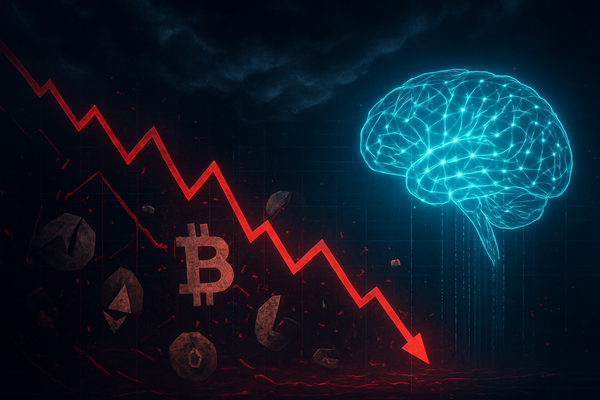Tech and Semiconductors Navigate AI Enthusiasm Amidst Mounting Headwinds

November 20, 2025 - The Technology and Semiconductor sectors are currently navigating a complex and often contradictory landscape. While propelled by the insatiable demand for Artificial Intelligence (AI) technologies, which has driven significant growth and record-breaking projections, the industry grapples with a confluence of economic uncertainties, geopolitical tensions, and persistent anxieties regarding an "AI Bubble." This dual narrative of robust innovation and underlying caution defines the market's current trajectory, demanding a strategic and discerning approach from investors and industry leaders alike.
Immediate implications suggest a sustained, AI-driven growth engine, particularly for foundational infrastructure providers, albeit with heightened investor scrutiny on valuations and tangible profitability. Market volatility is expected to continue, especially for high-growth AI stocks, as macroeconomic pressures intersect with strong earnings reports. Companies are actively adapting through diversified supply chains and disciplined investment, while significant capital expenditure continues to fuel expansion in advanced chip manufacturing and AI-specific research and development.
A Tumultuous Journey: Geopolitical Strife and the AI Ascent
The journey to the current state of the Technology and Semiconductor sectors has been marked by a series of pivotal events, intertwining geopolitical tensions with the explosive rise of Artificial Intelligence. Starting in late 2022, the "chip war" escalated significantly with stringent U.S. export controls on advanced semiconductor technology targeting China, including Electronic Design Automation (EDA) tools. China retaliated in July 2023 with export restrictions on critical minerals like gallium and germanium, vital for chip manufacturing, illustrating the deepening trade chasm. This tit-for-tat continued into 2025, with advanced semiconductor export controls actually increasing, despite a brief "Geneva agreement" on tariff reductions in May.
The year 2024 saw the U.S. CHIPS and Science Act, enacted in August 2022, begin to yield tangible results, with significant investments like a $6.6 billion pledge to Taiwan Semiconductor Manufacturing Co. (NYSE: TSM) for its Arizona expansion, which commenced 4nm wafer production in April 2024. Despite these efforts to bolster domestic manufacturing, an "inventory glut" in Q1 2024 impacted many semiconductor firms, excluding AI leaders, leading to falling revenues and calls for a market "correction." However, the AI boom quickly overshadowed these concerns. By late 2024, Advanced Micro Devices (NASDAQ: AMD) saw a dip in its stock due to unmet high expectations for its AI chip sales guidance, while NVIDIA (NASDAQ: NVDA) reached a forward P/E ratio of 50x, sparking early valuation debates.
By November 2025, AI bubble fears had intensified, becoming a dominant market concern. A Bank of America survey revealed that 45% of global fund managers considered an AI stock bubble the largest perceived market risk, with a majority believing AI stocks are already in a bubble. Initial market reactions included a slight decline in U.S. tech stocks, with the tech-heavy Nasdaq closing below a key technical indicator in early November. Major players like Amazon (NASDAQ: AMZN), Microsoft (NASDAQ: MSFT), and NVIDIA (NASDAQ: NVDA) experienced declines as investors re-evaluated speculative assets. However, NVIDIA (NASDAQ: NVDA) delivered an upbeat revenue forecast of approximately $65 billion for the January quarter, pushing back on immediate bubble fears and underscoring robust demand for its AI accelerators. Amazon (NASDAQ: AMZN) further solidified its AI commitment with a significant $38 billion partnership with OpenAI.
Key players have exhibited varied performances. NVIDIA (NASDAQ: NVDA) remains the primary beneficiary of the AI boom, with its GPUs being critical for AI development, and its AI-related sales estimated to be over $100 billion. TSMC (NYSE: TSM) nearly doubled its stock price in 2024, driven by strong demand for advanced technologies, projecting revenue growth in the mid-30% range for 2025. Intel (NASDAQ: INTC), after a challenging 2024 marked by leadership instability and underperformance, anticipates a turnaround in 2025, aided by significant CHIPS Act subsidies. AMD (NASDAQ: AMD) also showed strong performance in its data center segment, with data center GPU revenue expected to exceed $5 billion in 2024. Cloud giants Microsoft (NASDAQ: MSFT), Amazon (NASDAQ: AMZN), and Alphabet (NASDAQ: GOOGL) (NASDAQ: GOOG) are making massive capital expenditures—$80-90 billion, $100 billion, and $85 billion respectively for 2025—to expand their AI data center capacities, signaling unwavering confidence in the long-term potential of AI despite current high investment costs.
Winners and Losers in a Volatile Market
The current market conditions, characterized by both the AI gold rush and persistent economic anxieties, are creating a clear divide between potential winners and losers in the Technology and Semiconductor sectors. Companies with strong, verifiable AI-driven revenue streams, critical infrastructure contributions, and diversified business models are generally well-positioned, while those reliant on traditional markets or speculative AI ventures face significant headwinds.
NVIDIA (NASDAQ: NVDA) remains at the forefront of the AI revolution, with its GPUs and CUDA software ecosystem being indispensable for AI training and inference. The company projects continued revenue growth exceeding 50% annually through at least 2026, driven by unprecedented data center demand. Despite its high valuation (forward P/E ratio around 50x in late 2024), NVIDIA's stock performance often serves as a proxy for the entire AI investment thesis, with demand for its new Blackwell platform reportedly "off the charts." Similarly, Taiwan Semiconductor Manufacturing Co. (NYSE: TSM), as the world's leading semiconductor foundry, is a critical enabler of AI infrastructure, manufacturing advanced chips for major designers like NVIDIA (NASDAQ: NVDA) and Advanced Micro Devices (NASDAQ: AMD). Its foundational role positions it to benefit from ongoing AI demand, irrespective of which chip designers ultimately lead.
Diversified tech giants like Microsoft (NASDAQ: MSFT) are also strong contenders, leveraging their vast enterprise software offerings (e.g., Copilot for Microsoft 365, Azure AI Services) and making substantial capital expenditures for AI infrastructure. Microsoft's strategic integration of AI across its extensive product ecosystem provides resilience against market volatility. Advanced Micro Devices (NASDAQ: AMD) is gaining significant traction in server CPUs with its MI300 series and is one of the few companies with chips capable of powering AI technology, benefiting from increasing AI budgets from large tech companies. Broadcom (NASDAQ: AVGO), a designer of semiconductor chips and infrastructure software, is also well-positioned due to strong demand in AI-related semiconductors and collaborations with major tech firms for specialized AI chips. Applied Materials (NASDAQ: AMAT), providing crucial wafer fab equipment, is set to benefit from the demand for leading-edge foundry-logic, DRAM, and high-bandwidth memory driven by AI computing.
Conversely, companies that are over-reliant on speculative, unprofitable AI ventures are highly vulnerable. Many nascent AI companies, despite attracting substantial investment, lack clear paths to profitability, making them susceptible to a potential "AI bubble" burst as investors shift from hype to demand for tangible returns. Legacy automotive chipmakers and traditional market players, such as Infineon (XTRA: IFX), Texas Instruments (NASDAQ: TXN), and NXP Semiconductors (NASDAQ: NXPI), are grappling with oversupply and weak demand in their core segments, leading to anticipated revenue declines. Even Intel (NASDAQ: INTC), despite efforts to rebound and significant CHIPS Act subsidies, faces intense competition and challenges in advanced manufacturing, leading to underperformance compared to AI-pure plays. Certain memory chipmakers focused on older DRAM and NAND Flash, like Micron Technology (NASDAQ: MU), also face a bearish outlook due to potential oversupply, despite strong demand for High-Bandwidth Memory (HBM) for AI. Even the "Magnificent Seven" tech giants like Apple (NASDAQ: AAPL), Meta Platforms (NASDAQ: META), and Amazon (NASDAQ: AMZN), despite their robust fundamentals and AI investments, are not immune to short-term volatility due to their high valuations and significant weighting in major indices, making them susceptible to broad market corrections driven by AI bubble fears.
Wider Significance: A New Era of Transformation and Trepidation
The current market conditions in the Technology and Semiconductor sectors hold wider significance, signaling not just a cyclical downturn but a profound industrial transformation alongside heightened systemic risks. The prevailing "headwinds" and "AI Bubble" fears are shaping broader industry trends, creating ripple effects across the competitive landscape, and prompting significant regulatory and policy considerations, all while evoking echoes of past market frenzies.
At the heart of this transformation is AI, which has transitioned from an emerging technology to a foundational shift. Generative AI, in particular, is rapidly moving from pilot projects to full-scale enterprise deployments, driving global AI spending to a projected compound annual growth rate of 29% from 2024 to 2028. This relentless demand fuels an "infrastructure arms race," leading to massive capital expenditures focused on memory and logic chips, with hyperscalers rapidly expanding data center capacity. However, this growth is creating memory bottlenecks, particularly for high-end DRAM, leading to dramatic repricing and potentially leaving smaller to mid-sized companies facing supply constraints and higher costs. Beyond generative AI, emerging trends for 2025 include agentic AI, post-quantum cryptography, spatial computing, and robust AI governance platforms, underscoring the pervasive nature of this technological wave.
The ripple effects on competitors and partners are creating a bifurcated industry. Top-tier firms heavily invested in AI, such as NVIDIA (NASDAQ: NVDA) and TSMC (NYSE: TSM), are solidifying their dominance, while traditional semiconductor segments (e.g., automotive, industrial electronics) face oversupply and weaker demand. This could lead to an "uneven transfer of wealth," where larger, AI-aligned companies thrive, potentially at the expense of smaller players struggling to adapt or secure critical components. The prioritization of AI demand by major chipmakers means smaller and mid-sized companies may face significant challenges in securing components, leading to product launch delays or increased costs. This intense focus on AI also fosters accelerated innovation and competition, creating new opportunities for partners offering AI integration, cybersecurity, and supply chain optimization, but also intensifying the battle for talent and market share.
Regulatory and policy implications are rapidly evolving in response to these dynamics. Geopolitical tensions, notably between the U.S. and China, continue to drive trade policies like the U.S. CHIPS Act, aiming to decentralize semiconductor manufacturing and bolster domestic production. New export controls on advanced semiconductor technologies and manufacturing equipment are expected to further restrict market access for certain entities, while tariffs remain a tool to influence trade. Furthermore, the rapid advancement of AI is prompting urgent discussions around responsible innovation, with "AI Governance Platforms" emerging as a top technology trend for 2025. This signals a growing need for legal, ethical, and operational frameworks to manage AI systems, suggesting impending regulations or industry standards to address concerns around transparency, fairness, and accountability.
Historically, the current "AI Bubble" fears draw prevalent comparisons to the dot-com bubble of the late 1990s. Market observers point to high valuations, speculative investment, and a heavy reliance on a few dominant tech companies, alongside concerns that vast investment spending might harm and delay investor returns, echoing sentiments from that era. Some prominent investors, like Michael Burry, have expressed skepticism, shorting AI-linked stocks. However, key distinctions exist; current tech sector valuations, while elevated, are not yet at the extreme levels seen in 2000. Proponents argue that the demand for AI infrastructure is real, widespread, and driven by tangible enterprise adoption, contrasting with some of the more speculative business models of the dot-com era. The unprecedented scale of capital expenditure in physical infrastructure, such as data centers costing tens of billions, is a distinguishing feature. Rather than a uniform market crash, many analysts predict an "uneven transfer of wealth" or a "shake-out" where larger, well-established firms with sustainable business models are expected to weather any correction more effectively, potentially consolidating power and reshaping the industry landscape.
What Comes Next: Navigating the AI Frontier
The immediate future for the Technology and Semiconductor sectors, spanning 2025-2026, will likely see continued AI dominance. AI hardware, particularly chips and accelerators, will experience steady growth, even with a moderated purchasing pace from hyperscalers as enterprises increasingly invest in in-house AI infrastructure for cost-effective inference solutions. The electronic components industry is poised for continued recovery, stabilizing in the latter half of 2025. Growth will remain segmented, with AI, high-performance computing (HPC), and automotive (especially EVs) driving strong demand, while traditional PC and smartphone markets see more modest single-digit growth, albeit with a potential boost from the debut of AI smartphones and laptops. Capital expenditure in the semiconductor industry is projected to reach around $185 billion in 2025, expanding manufacturing capacity by 7% to meet this AI-driven demand.
Looking further ahead, towards 2030 and beyond, the semiconductor market is projected to surpass $1 trillion, potentially reaching $2 trillion by 2040, with AI contributing up to $15.7 trillion to the global economy. "AI Everywhere" is the long-term vision, with agentic AI and autonomous decision systems moving from pilots to widespread enterprise infrastructure. Advanced computing, including cloud and edge computing, along with advanced connectivity, will remain crucial growth engines. Transformative technologies such as advanced packaging (chiplets, 3D IC, CoWoS), new materials, and neuromorphic computing will redefine chip performance and energy efficiency. Sector-specific growth will be notable in automotive semiconductors, particularly for EVs, and the global robotics market. The nascent quantum computing market is also projected for significant expansion.
Strategic pivots are paramount for companies to thrive in this evolving landscape. Building resilient and diversified supply chains is critical to mitigate geopolitical risks and trade restrictions. AI-centric innovation, focusing on high-performance computing, memory (HBM), and custom silicon solutions, will be key for semiconductor manufacturers. Cybersecurity must be deeply integrated into all stages of technology development, and energy efficiency will become a crucial innovation driver as AI data centers consume vast amounts of power. Addressing the persistent talent shortage in the semiconductor sector and focusing on responsible AI development, ensuring transparency and accountability, are also vital for sustained growth and public trust. Emerging market opportunities are concentrated in the Asia-Pacific region for manufacturing, while government initiatives like the U.S. CHIPS Act create regional investment hubs.
Potential scenarios range from an "Optimistic Transformation," where AI continues to drive robust growth and productivity gains, pushing market valuations higher, to a "Stratified Development," where AI demand remains highly concentrated in specific components, leading to targeted shortages while non-AI segments lag. The most cautious scenario involves an "AI Bubble Burst and Market Correction," where concerns about inflated valuations and the lack of widespread AI profitability materialize into a significant market pullback. However, even in this scenario, the underlying technological advancements of AI are likely to persist, with more established and profitable companies weathering the storm and driving a more sustainable growth phase. As of late 2025, the market exhibits signs of both buoyant growth and underlying apprehension, with NVIDIA's strong performance offering a temporary reprieve from bubble fears, but the long-term sustainability of current investment levels and broad AI monetization remains a critical question.
Wrap-up: Navigating a Transformative Yet Treacherous Landscape
The Technology and Semiconductor sectors, as of November 20, 2025, stand at a critical juncture, defined by the unstoppable momentum of AI innovation intersecting with significant macroeconomic headwinds and a pervasive "AI Bubble" debate. Key takeaways include AI's undeniable role as the dominant catalyst for growth, driving unprecedented demand for advanced chips and cloud infrastructure. While the market has experienced considerable volatility, particularly in mid-November, the underlying trajectory for both sectors, especially semiconductors, remains one of strong growth and increasing sales, projected to reach $1 trillion by 2030. However, valuation concerns are real, with a substantial portion of the market believing an "AI bubble" exists, making valuation scrutiny a critical area of investor focus. Geopolitical tensions are not temporary disruptions but structural forces reshaping global supply chains, and innovation within AI is accelerating, revolutionizing chip design and manufacturing.
Moving forward, the market outlook remains largely positive, albeit tempered by the aforementioned risks. Global IT spending is forecast for continued robust growth, with the semiconductor market projected to reach $760.7 billion in 2026, an 8.5% increase, potentially hitting $800 billion that year. Data centers, particularly for accelerators and processors supporting large language models (LLMs), will drive significant growth. Technological advancements, such as the transition to gate-all-around (GAA) transistors for 2nm manufacturing processes, will be pivotal in 2026, promising lower power consumption and improved performance. High-bandwidth memory (HBM) will continue its ascent, exclusively for AI accelerators, and automotive and EV semiconductor demand is expected to see double-digit growth. Government initiatives, like the CHIPS Act, will continue to bolster domestic manufacturing, enhancing supply chain resilience.
The lasting impact of these conditions is profound: AI is not merely a transient trend but a fundamental, transformative force ushering in an "AI-first innovation" era. This necessitates continuous R&D and massive capital expenditures to expand manufacturing capacity and push the boundaries of chip design. The strategic importance of semiconductors has elevated them to a matter of national security, reshaping global trade dynamics and leading to significant government involvement. For investors, the coming months demand a blend of optimism for long-term growth and caution regarding short-term volatility. It is crucial to monitor macroeconomic indicators, scrutinize valuations and profitability beyond speculative enthusiasm, and diversify within tech and semiconductors. Tracking geopolitical developments, focusing on foundational AI infrastructure (data centers, advanced packaging, next-gen manufacturing), and closely watching earnings reports from major players like NVIDIA (NASDAQ: NVDA) will provide crucial insights into the health and direction of these vital industries. Despite short-term fluctuations, the long-term drivers of AI adoption and digital transformation suggest that market dips could present compelling opportunities for discerning, long-term investors.
This content is intended for informational purposes only and is not financial advice



